
Cockatoo Island is a UNESCO World Heritage Site at the junction of the Parramatta and Lane Cove River in Sydney Harbour, New South Wales, Australia.
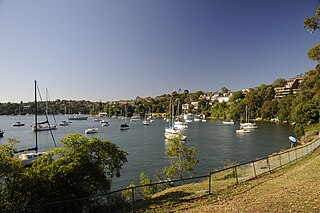
Greenwich is a suburb on the Lower North Shore of Sydney, in the state of New South Wales, Australia. Greenwich is located 7 kilometres (4.3 mi) north-west of the Sydney central business district, in the local government area of the Municipality of Lane Cove.
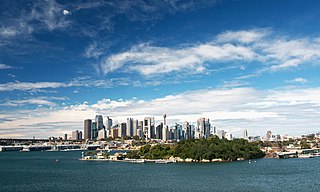
Goat Island is a heritage-listed island located in Port Jackson, in Sydney, New South Wales, Australia. Located north-west of the Sydney central business district, Goat Island is about 300m wide in a north/south direction and 180m long in an east/west direction; and covers an area of 5.4 hectares. Goat Island lies off the shores of the Sydney suburbs of Balmain and Millers Point, at the junction of Darling Harbour with the main channel of Sydney Harbour.

Snapper Island is a 1.65-hectare (4.1-acre) island in Sydney Harbour, Australia. It lies in the main channel of the western section of the harbour, upstream of the Sydney Harbour Bridge, adjacent to the Sydney suburb of Drummoyne.

The Cockatoo Island Dockyard was a major dockyard in Sydney, Australia, based on Cockatoo Island. The dockyard was established in 1857 to maintain Royal Navy warships. It later built and repaired military and battle ships, and played a key role in sustaining the Royal Australian Navy. The dockyard was closed in 1991, and its remnants are heritage listed as the Cockatoo Island Industrial Conservation Area.

The Dawes Point Battery remains is a heritage-listed former artillery fortification and now visitor attraction located adjacent to the southern pylon of the Sydney Harbour Bridge at Hickson Road in inner city Sydney, on the boundary between Dawes Point and The Rocks in the City of Sydney local government area of New South Wales, Australia. It was built and modified from 1791 to 1925 by Lieutenant William Dawes, Robert Ross, Francis Greenway, and George Barney. The property is owned by Property NSW, an agency of the Government of New South Wales. It was added to the New South Wales State Heritage Register on 10 May 2002.

Mort's Dock is a former dry dock, slipway, and shipyard in Balmain, New South Wales, Australia. It was the first dry dock in Australia, opening for business in 1855 and closing more than a century later in 1959. The site is now parkland.
Williamstown Dockyard was one of Australia's principal ship building yards at Williamstown, Victoria, Australia.
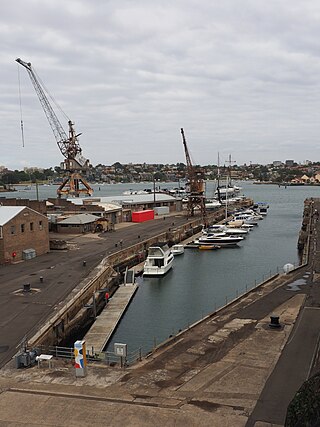
Sutherland Dock is a heritage-listed dockyard at the former Cockatoo Island Dockyard, Cockatoo Island, New South Wales, Australia. It was added to the Australian Commonwealth Heritage List on 22 June 2004.
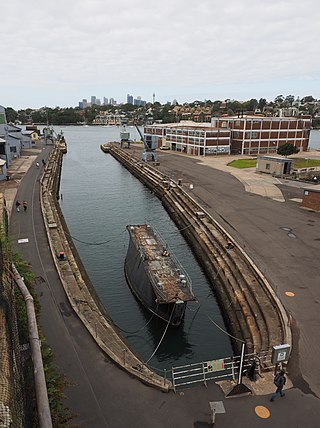
Fitzroy Dock is a heritage-listed dockyard at the former Cockatoo Island Dockyard, Cockatoo Island, Sydney Harbour, New South Wales, Australia. It was added to the Australian Commonwealth Heritage List on 22 June 2004.
The Walsh Island Dockyard and Engineering Works was a dockyard and engineering workshop established by the Government of New South Wales in 1913, at Walsh Island, Newcastle, Australia. The foundation stone was laid on 15 June 1913 by Arthur Griffith, the Minister for Works. The dockyard was constructed as a replacement for Sydney's Cockatoo Island Dockyard, that was taken over by the Federal Government in 1913.

Biloela House is a house at the centre of a heritage-listed historic precinct on Cockatoo Island, Sydney Harbour, New South Wales, Australia. It was added to the Australian Commonwealth Heritage List on 22 June 2004.
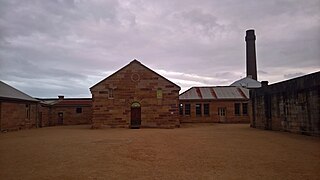
Prison Barracks Precinct is a heritage-listed prison precinct at Cockatoo Island, Sydney Harbour, New South Wales, Australia. It was added to the Australian Commonwealth Heritage List on 22 June 2004.

Convict Barracks Block is a heritage-listed convict barracks within the Prison Barracks Precinct, Cockatoo Island, Sydney Harbour, New South Wales, Australia. It was added to the Australian Commonwealth Heritage List on 22 June 2004.

Military Guard Room is a heritage-listed military installation within the Prison Barracks Precinct, Cockatoo Island, Sydney Harbour, New South Wales, Australia. It was added to the Australian Commonwealth Heritage List on 22 June 2004.

Mess Hall is a heritage-listed part of the Prison Barracks Precinct at Cockatoo Island, New South Wales, Australia. It is also known as Mess Hall (former). It was added to the Australian Commonwealth Heritage List on 22 June 2004.

Cockatoo Island Industrial Conservation Area is a heritage-listed protected area relating to the former Cockatoo Island Dockyard at Cockatoo Island, Sydney Harbour, New South Wales, Australia. It was added to the Australian Commonwealth Heritage List on 22 June 2004.

Power House & Pump House is a heritage-listed power house and pumping station at Cockatoo Island, Sydney Harbour, New South Wales, Australia. It was added to the Australian Commonwealth Heritage List on 22 June 2004.

The Garden Island Naval Precinct is a heritage-listed naval base and defence precinct located at Cowper Wharf Roadway in the inner eastern Sydney neighbourhood of Garden Island in the City of Sydney local government area of New South Wales, Australia. The precinct was built from 1856. It includes the HMAS Kuttabul naval base, formerly known as HMAS Penguin. The property is owned by Australian Department of Defence. It was added to the Commonwealth Heritage List on 22 June 2004 and the New South Wales State Heritage Register on 12 November 2004.

Sydney Cove West Archaeological Precinct is a heritage-listed precinct that contains The Rocks police station, the Museum of Contemporary Art Australia, car park, parks, shops and roads located at 112-156 George Street, in the inner city Sydney suburb of The Rocks in the City of Sydney local government area of New South Wales, Australia. The precinct previously contained a commissariat store, Maritime Services Board offices, dockyard and Department of Labour & Industry offices. Buildings in the precinct were developed in various stages since 1797 to date, with heritage-listed buildings dating from 1797 to 1939. The precinct is also known as the Museum of Contemporary Art, Maritime Services Board, Colonial Government naval dockyard, Commissariat Stores, Colonial Hospital, Kings and Queens Wharf and First Fleet Park. The property is owned by Property NSW, an agency of the Government of New South Wales. It was added to the New South Wales State Heritage Register on 5 August 2011.



















